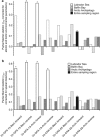Effects of environmental variation and spatial distance on bacteria, archaea and viruses in sub-polar and arctic waters
- PMID: 23552622
- PMCID: PMC3721122
- DOI: 10.1038/ismej.2013.56
Effects of environmental variation and spatial distance on bacteria, archaea and viruses in sub-polar and arctic waters
Abstract
We investigated the influence of environmental parameters and spatial distance on bacterial, archaeal and viral community composition from 13 sites along a 3200-km long voyage from Halifax to Kugluktuk (Canada) through the Labrador Sea, Baffin Bay and the Arctic Archipelago. Variation partitioning was used to disentangle the effects of environmental parameters, spatial distance and spatially correlated environmental parameters on prokaryotic and viral communities. Viral and prokaryotic community composition were related in the Labrador Sea, but were independent of each other in Baffin Bay and the Arctic Archipelago. In oceans, the dominant dispersal mechanism for prokaryotes and viruses is the movement of water masses, thus, dispersal for both groups is passive and similar. Nevertheless, spatial distance explained 7-19% of the variation in viral community composition in the Arctic Archipelago, but was not a significant predictor of bacterial or archaeal community composition in either sampling area, suggesting a decoupling of the processes regulating community composition within these taxonomic groups. According to the metacommunity theory, patterns in bacterial and archaeal community composition suggest a role for species sorting, while patterns of virus community composition are consistent with species sorting in the Labrador Sea and suggest a potential role of mass effects in the Arctic Archipelago. Given that, a specific prokaryotic taxon may be infected by multiple viruses with high reproductive potential, our results suggest that viral community composition was subject to a high turnover relative to prokaryotic community composition in the Arctic Archipelago.
Figures



References
-
- Agogué H, Brink M, Dinasquet J, Herndl GJ. Major gradients in putatively nitrifying and non-nitrifying Archaea in the deep North Atlantic. Nature. 2008;456:788–791. - PubMed
-
- Baas Becking LGM. Geobiologie of inleiding tot de milieukunde. W. P. Van Stockum and Zoon: Den Haag; 1934.
-
- Baudoux A-C, Veldhuis MJW, Witte HJ, Brussaard CPD. Viruses as mortality agents of picophytoplankton in the deep chlorophyll maximum layer during IRONAGES III. Limnol Oceanogr. 2007;52:2519–2529.
Publication types
MeSH terms
Substances
Grants and funding
LinkOut - more resources
Full Text Sources
Other Literature Sources

